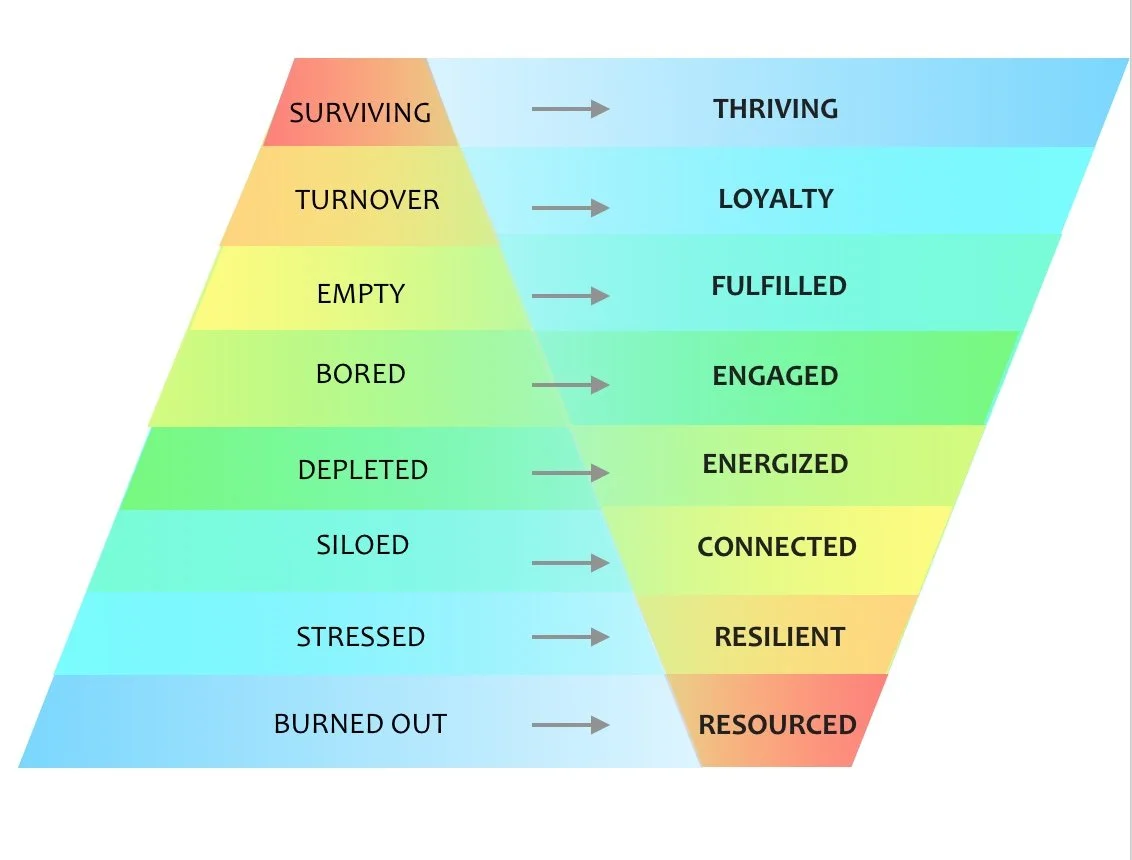
Connection-Led Leadership
Connection isn’t a mindset — it’s a measurable skill.
Our programs help leaders and teams transform stress into trust, reactivity into collaboration, and pressure into purpose.
Whether you lead a growing company, a global team, or an executive board, every conversation is either building connection or eroding it.
We teach you how to recognize the difference — and how to make connection your organization’s greatest strategic advantage.
7 Core Connection Principles
-
Leadership today moves fast — but speed without connection comes at a cost. When stress drives performance, productivity becomes fragile: burnout rises, collaboration erodes, and top talent disengages.
Connection-Led leadership reverses that trend. It’s a science-backed framework that helps leaders build trust, engagement, and resilience — the foundations of sustainable performance.
Connection isn’t a “soft skill.” It’s a strategic advantage. Teams led through connection show higher innovation, lower turnover, stronger collaboration, and measurable gains in productivity and retention.
Why? Because connection regulates the nervous system — in people and in organizations. When leaders learn to pause, sense, and respond instead of react, they shift the system from stress to safety. And in that physiology of safety, creativity, clarity, and accountability flourish naturally.
The seven Core Connection Principles teach leaders how to operationalize that shift — turning empathy into efficiency, authenticity into alignment, and care into culture. When leaders embody connection, they unlock the single greatest driver of performance: people who want to show up, not people who have to.
*A Note to the Skeptical MindAs you read these principles, you might notice a voice saying, “This feels too soft,” or “We don’t have time for this — we have work to do.” That voice isn’t wrong — it’s protective. It learned to thrive in systems that rewarded intellect, speed, and productivity over connection.
But leadership is evolving. The same drive that once fueled performance through pressure can now sustain it through connection. Investing time here isn’t indulgent — it’s strategic.
Teams that prioritize connection first spend far less time repairing disconnection later. Misunderstandings, reactivity, burnout, and turnover all drop — while engagement, creativity, and retention rise. The return compounds — like interest on a 401(k) for your culture.
So as you move through this framework, notice that skeptical voice, thank it for caring about results, and set it gently aside. Then ask yourself: What might become possible if effectiveness, well-being, and integrity all worked together — not against each other?
-
High-performing teams don’t thrive on pressure — they thrive on presence.
When a leader is calm and centered, people think more clearly, communicate more directly, and make better decisions under stress.Empathic presence is the discipline of staying grounded before reacting — noticing what’s happening in yourself, in the room, and in others. This steadiness creates psychological (and physiological) safety: people stop protecting themselves and start contributing.
In corporate life, empathic presence is what turns urgency into focus and conflict into collaboration. It’s leadership’s most underutilized advantage — composure that drives clarity and results.
-
Trust doesn’t grow from agreement — it grows from honesty with care.
Compassionate authenticity is the discipline of being direct without disconnecting — truth delivered through respect, the kind that aligns teams faster and prevents costly misunderstandings.
When leaders avoid truth to keep things smooth, real issues don’t disappear — they just go unspoken. When they deliver truth without empathy, people shut down. But when they bring both together — clarity and care — accountability and trust rise in tandem.
Compassionate authenticity replaces artificial harmony with real alignment.
It’s how leaders turn difficult conversations into forward movement. -
Top-performing organizations don’t run on INdependence — they run on INTERdependence: caring for others’ needs as part of meeting their own.
Care isn’t weakness — it’s a force multiplier. When leaders operate from this mindset, friction drops, accountability rises, and performance scales.
It’s the invisible infrastructure behind trust, speed, and execution. Leaders who regulate first and relate second replace friction with alignment — asking, “Am I creating the conditions for collaboration or competition?”
Interdependence turns silos into synergy and expertise into shared intelligence, where accountability is mutual and results scale faster.
Connection isn’t the opposite of efficiency — it’s what makes efficiency sustainable.
-
Empathy without boundaries leads to exhaustion. Boundaries without empathy lead to fear. Together, empathy and boundaries create the conditions for lasting performance.
Warm boundaries protect focus, energy, and trust. They prevent burnout by replacing unspoken expectations with shared agreements — so everyone knows the rules of engagement and how to win together.
Leaders who set limits with respect build stability: people feel valued and know where they stand.
Warm boundaries are how compassion becomes operational — turning care into clarity and clarity into performance.
-
Strong teams don’t just execute — they reflect, repair, and evolve.
Mourning and celebration are two sides of the same leadership discipline: learning from what hurt and amplifying what helped. Mourning transforms frustration into clarity; celebration converts success into culture.
Teams that practice both recover faster, collaborate deeper, and sustain high performance without burnout.
-
Rigid thinking slows innovation.
Dynamic leaders stay curious under pressure — replacing judgment with inquiry, blame with ownership, and reactivity with responsiveness.
This mindset keeps conversations alive and performance adaptive, turning friction into progress.
-
Culture cracks where systems contradict values.
Structural integrity means aligning what the organization says it values with how it actually operates — where leaders turn intention into reliability by building systems that treat people fairly, make expectations clear, and keep promises consistent.
That consistency builds confidence, loyalty, and long-term performance.
-
Connection-Led leadership is measurable. It reduces friction, accelerates decisions, and builds teams that think together instead of against each other.
When leaders start with connection, stress cycles shorten, reactivity drops, and collaboration rises. The result: fewer costly repairs, faster execution, and stronger retention.
This isn’t idealism — it’s infrastructure.
Cultures built on connection outperform those driven by pressure - because people work harder for trust than they ever will for fear, and trust builds momentum that control can’t sustain.
The Impact of Connection
When organizations invest in connection, the ROI is measurable:
Higher engagement and retention
Increased innovation and creativity
Reduced burnout and turnover
Stronger collaboration and communication
Greater adaptability through change
Connection doesn’t replace performance — it drives it.
It’s the foundation that allows teams to operate with both excellence and humanity.

